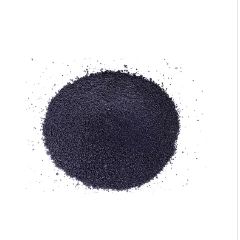indigo powder dye fabric
The Art and Science of Indigo Powder Dyeing Fabric
Indigo powder dyeing is one of the oldest and most revered techniques for coloring textiles, deeply rooted in various cultures across the world. This precise craft involves the use of indigo, a plant-derived dye that has been cherished for centuries for its rich, vibrant blue hues. From the ancient civilizations in Asia to contemporary fashion designers, indigo dyeing holds a special place in the world of fabric arts.
Historical Background
The history of indigo dyeing is as colorful as the dye itself. The use of indigo can be traced back over 6,000 years to ancient cultures in places like India, Egypt, and Japan. It was prized not only for its stunning color but also for its durability and resistance to fading. The plant from which indigo is derived, Indigofera tinctoria, thrives in tropical and subtropical regions and is known for its unique ability to yield blue dye through a fermentation process.
In ancient India, indigo was often referred to as blue gold due to its high value in trade. Indian indigo was exported through trade routes to Europe, where it became a staple of the textile industry. The popularity of indigo led to the establishment of indigo plantations, particularly during the colonial period, where it became an important cash crop. However, the methods of harvesting and processing often exploited local labor, which eventually led to significant social and economic changes.
The Dyeing Process
Indigo dyeing is a fascinating blend of art and science, requiring specific techniques to achieve the desired results. The process begins with the extraction of pigment from the indigo plant. Leaves are harvested and fermented to create a dye bath, which can involve the addition of other natural substances such as lye or sugar to aid the reduction of indigo, allowing it to dissolve in water.
Once the dye bath is ready, the fabric—typically made of cotton or linen—is prepped for dyeing. The preparation may include soaking in a mordant, a substance that helps fix the dye onto the fabric. The fabric is then submerged in the dye bath, allowing it to absorb the color. One interesting aspect of indigo dyeing is that the fabric will initially appear green when taken out of the dye bath due to the reduced form of indigo. Upon exposure to air, it oxidizes and transforms into a deep blue, showcasing the unique chemistry involved in the dyeing process.
indigo powder dye fabric

Cultural Significance
Indigo dyeing is not just about color; it holds significant cultural importance in various societies. In Japan, for instance, the traditional art of shibori, or tie-dyeing, utilizes indigo dyeing techniques to create intricate patterns. These textiles are not only beautiful but also encapsulate centuries of cultural heritage and craftsmanship.
In Africa, indigo dyeing practices vary by region, incorporating local motifs and designs. The traditional West African indigo-dyed cloth, often characterized by bold patterns and textures, serves not only as clothing but also as a means of storytelling and cultural expression.
Modern Applications
With the rise of sustainable fashion, indigo dyeing has found a renewed relevance in the contemporary textile industry. Designers are increasingly seeking eco-friendly alternatives to synthetic dyes, leading to a resurgence of interest in natural indigo dyeing. This aligns with a growing awareness of environmental issues and a push towards ethical production practices.
Artisans and small-scale producers are now embracing traditional indigo dyeing methods, often combining them with modern aesthetics. The appeal of one-of-a-kind, hand-dyed fabrics resonates with consumers seeking authenticity and craftsmanship in an age of mass production.
Conclusion
Indigo powder dyeing is more than just a method of coloring fabric; it is a bridge connecting past traditions with modern sensibilities. The deep blue hues that result from this ancient technique are not just visually stunning; they are a manifestation of history, culture, and a commitment to sustainable practices. As we continue to explore and innovate within the realms of fabric arts, the legacy of indigo dyeing remains a testament to the beauty and complexity of our craft. Whether worn as clothing, displayed as art, or utilized in design, dyed indigo fabric will always carry with it a story worth telling.
-
The Timeless Art of Denim Indigo Dye
NewsJul.01,2025
-
The Rise of Sulfur Dyed Denim
NewsJul.01,2025
-
The Rich Revival of the Best Indigo Dye
NewsJul.01,2025
-
The Enduring Strength of Sulphur Black
NewsJul.01,2025
-
The Ancient Art of Chinese Indigo Dye
NewsJul.01,2025
-
Industry Power of Indigo
NewsJul.01,2025
-
Black Sulfur is Leading the Next Wave
NewsJul.01,2025

Sulphur Black
1.Name: sulphur black; Sulfur Black; Sulphur Black 1;
2.Structure formula:
3.Molecule formula: C6H4N2O5
4.CAS No.: 1326-82-5
5.HS code: 32041911
6.Product specification:Appearance:black phosphorus flakes; black liquid

Bromo Indigo; Vat Bromo-Indigo; C.I.Vat Blue 5
1.Name: Bromo indigo; Vat bromo-indigo; C.I.Vat blue 5;
2.Structure formula:
3.Molecule formula: C16H6Br4N2O2
4.CAS No.: 2475-31-2
5.HS code: 3204151000 6.Major usage and instruction: Be mainly used to dye cotton fabrics.

Indigo Blue Vat Blue
1.Name: indigo blue,vat blue 1,
2.Structure formula:
3.Molecule formula: C16H10N2O2
4.. CAS No.: 482-89-3
5.Molecule weight: 262.62
6.HS code: 3204151000
7.Major usage and instruction: Be mainly used to dye cotton fabrics.

